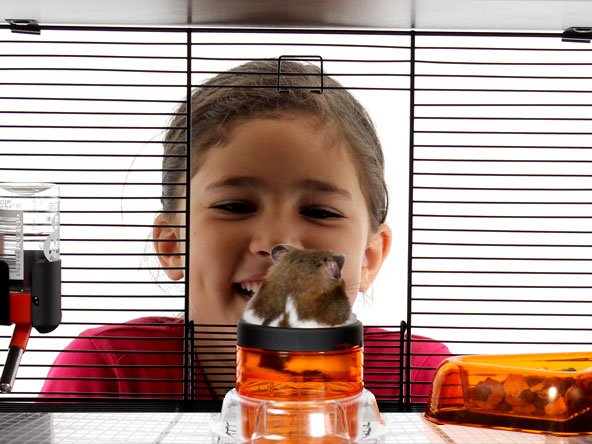Top expert tips when buying a hamster
Emma, one of our trusted Veterinary Nurses, tells us her tops tips when buying a hamster.

Hamsters are a popular pet, particularly for young children, and owning a
hamster can be a very enjoyable and rewarding experience. They are
inquisitive, nocturnal animals with an average life span of around two three
years.
If you are thinking of taking on the responsibility of caring for a hamster, below
are some things to consider before you introduce a new furry friend into your
home.
Which breed is best?
There are many different breeds of hamster but the most popular breeds are
Syrian, Russian Dwarf or Roborovski hamster. There is no ‘best’ breed,
however, Syrian hamster are naturally solitary animals so you must only keep
one – put two adults together and they will fight which can result in death. The
smaller dwarf varieties of hamster are more social but it is best to keep them in
female only pairs or small groups as males can still fight. NEVER mix breeds!
Where will they live?
Hamsters require a warm, dry and draught free place to leave, in a relatively
quiet part of the house. Remember, they are nocturnal animals so will be up
and about when everyone else is asleep so it is advisable not to house them in a
bedroom – unless you want to be woken up every night! They are also very
sensitive to light and noise so are best kept away from computers, televisions,
washing machines and tumble dryers. Hamsters like to burrow and build nests so a suitable cage must provide an area
that is deep enough for them to express these natural behaviours. They also
like to climb so a home split over different levels accessed via tubes and ladders
is preferable. Shredded paper, dry peat and dust extracted bedding materials are suitable for
all breeds of hamster. Avoid ‘fluffy’ bedding as this can become tangled around
their little legs, cutting off the blood supply resulting in amputation. It can also
cause serious problems if they eat it. Their cage will need to be cleaned out once a week.
What should I feed my hamster?
A good quality commercial hamster mix will provide them with the nutrients they
require to stay fit healthy. But it is also important to supplement this diet with
some fresh fruit and vegetables – a piece of apple, carrot or broccoli will be
greatly appreciated! But remember, hamsters like to bury their food so only
give a very small piece to help ensure food isn’t left to rot in their cage.
Did you know..? A hamsters front teeth grow all the time! They will naturally
grind together to wear them down, but it is also important they are provided
with things to gnaw on – a dog biscuit works well! Or a piece of fruit tree twig –
good pet shops will have sticks you can buy that will help keep their teeth in tiptop
shape. They also appreciate a toilet roll tube, or two!
What should I look for when buying a hamster?
Hamsters should have bright, clean eyes and should not have any discharge
around their eyes, nose or mouth, nor should they sound ‘snuffly.’ Also check
their bottoms – they should be clean and dry with no signs of diarrhoea or
‘wetness’.
A reputable supplier will also be able to confidently tell you the sex of the
hamster – if they seem unsure, walk away. You do not want to end up with a
pregnant hamster or two males that will fight.
How do I tell if my hamster is poorly?
Hamsters naturally store their food in pouches located in their cheeks, which can
sometimes cause problems. The food can become impacted and infection can
result. If your hamster looks like it permanently has ‘full’ cheeks, seek
veterinary advice, they may require this food to be removed and a course of
antibiotics to clear up any infection. The most common problem with hamsters is ‘wet tail’ – diarrhoea which can be
brought on by stress. To help avoid this, ensure that your hamsters new cage is
all ready for them when you bring them home and allow them 2-3
days of being largely undisturbed (apart from providing food and fresh water) to allow them to
settle in to their new environment.
My hamster has dark patches on its side – what’s wrong?
Nothing! Hamsters have scent glands located on their flanks. These can look
like dark patches and are completely normal.
Remember… your hamster is short sighted so keep a close eye on them if you let
them out of their cage for some exercise.
If you are worried about your hamster at any time, call your local veterinary
practice, they will be happy to offer advice over the telephone or see your
hamster, if required.
No comments yet - Leave a comment
This entry was posted in Hamsters on August 24th, 2016 by admin